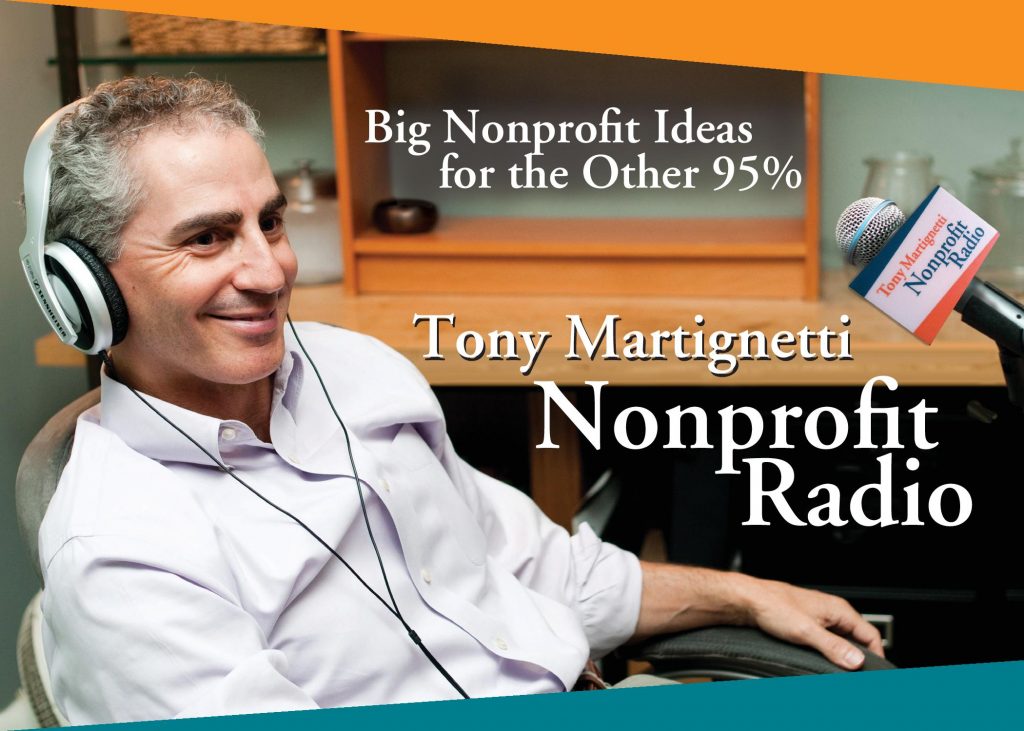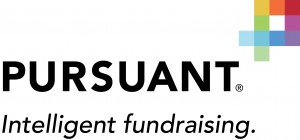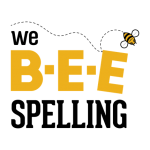I love our sponsors!
Do you want to find more prospects & raise more money? Pursuant is a full-service fundraising agency, leveraging data & technology.
It’s not your 7th grade spelling bee! We Bee Spelling produces charity fundraiser spelling bees with stand-up comedy, live music & dance. It’s all in the video!
Get Nonprofit Radio insider alerts!
Listen Live or Archive:
- On Fridays at 1pm Eastern: Talking Alternative Radio and tune in
- Listen to the March 10, 2017 archived podcast
My Guest:
William MacAskill: Doing Good Better

William MacAskill is the author of “Doing Good Better,” a book that introduces effective altruism for individuals. There are worthy takeaways for your nonprofit as we discuss how your donors can give smarter to make the greatest difference. (Originally aired Aug 14, 2015)
Top Trends. Sound Advice. Lively Conversation.
Board relations. Fundraising. Volunteer management. Prospect research. Legal compliance. Accounting. Finance. Investments. Donor relations. Public relations. Marketing. Technology. Social media.
Every nonprofit struggles with these issues. Big nonprofits hire experts. The other 95% listen to Tony Martignetti Nonprofit Radio. Trusted experts and leading thinkers join me each week to tackle the tough issues. If you have big dreams but a small budget, you have a home at Tony Martignetti Nonprofit Radio.
Get Nonprofit Radio insider alerts!
Sponsored by:
Processed on: 2018-11-11T23:36:10.887Z
S3 bucket containing transcription results: transcript.results
Link to bucket: s3.console.aws.amazon.com/s3/buckets/transcript.results
Path to JSON: 2017…03…330_tony_martignetti_nonprofit_radio_20170310.mp3.98669741.json
Path to text: transcripts/2017/03/330_tony_martignetti_nonprofit_radio_20170310.txt
Hello and welcome to tony martignetti non-profit radio big non-profit ideas for the other ninety five percent. I’m your aptly named host. Oh, i’m glad you’re with me, i’d suffer. The embarrassment of hemi ble is mus if you shook me up with the idea that you missed today’s show, doing good better. William mccaskill is the author of doing good better, a book that introduces effective altruism for individuals. There are worthy takeaways for your non-profit as we discussed how your donors can give smarter to make the greatest difference that originally aired august fourteenth, twenty fifteen tony steak to jump start your planned e-giving we’re sponsored by pursuant full service fund-raising data driven and technology enabled, you’ll raise more money pursuing to dot com, and by we be spelling supercool spelling bee fundraisers we b e spelling dot com here is william mccaskill and doing good, better it’s time to welcome my guest william mccaskill, associate professor in philosophy at oxford university and co founder of the nonprofit organizations e-giving what we can and eighty thousand hours. They’ve raised over four hundred million dollars in lifetime, pledged donations to charities and helped spark the effective altruism movement, which will be talking a lot about you may have heard about will and his organizations in the new york times, the wall street journal, national public radio and ted talks. He lives in oxford, england, but he’s calling from somewhere on the west coast. I’m not sure where to talk about his new book. Doing good better how effective altruism can help you make a difference published just in april by gotham books. It’s, an imprint of penguin random house he’s at will mccaskill on twitter. Well, mccaskill welcome to tony martignetti non-profit radio. I’m going to speak to you. It’s. A pleasure. Where are you calling from? Calling the man view just outside of san francisco. Okay. Cool. Is it? Is it beautiful there in in mountain view today. It’s beautiful every day and manage everything as opposed to as opposed to oxford, which is probably not beautiful every day. No it’s, really gray and rainy most days wait. Quite pleasant experience being in the california summer. Love it. Wonderful. Welcome. Um, effective altruism. What you’re you’re working at the intersection of economics, psychology and philosophy. What is this about effects? Folks? Ism is about using your time and money as effectively as possible to make the world a better place. That means taking a scientific approach using high quality evidence, good data, careful, logical reasoning in order to ensure that when you give to charity or when you choose a career you’re aiming to use to make a difference, they’re using it did not just make a difference, but to make the most difference, you can’t the most. The biggest possible difference. That’s, right? And so there’s a lot of economic theory wrapped up in this and it’s effective altruism is is on the book is devoted to individuals, and they’re giving right? Yep. Okay, but we’re going to draw a lot of lessons for non-profits because there are there are valuable lessons there in in what you’re, uh, recommending for for individuals. Um, i love i love stories. So could we and you introduce ah, the, uh, the theory of effective altruism with a ah de worming story in kenya. Can you can you share that, please? At sure. So in the nineteen nineties, uh, michael claim a who is? Ah, development economists that harvard he was. He was working in kenya and he’s working with a charity called i c s that did a variety of education programs for the poor and that currency on dh he was working with him on dh. He just had the obvious question, which was, well, have you actually tested this to see if it works to see how effective it wass andi answer was that they had on dh. In fact, at the time, basically, no one had bean doing high quality experiments to test different development programs, and so what they did was they started investigating a ll the different things that this child he was doing and the results were really interesting. So they take something that seemed very obviously like you have a big impact distributing textbooks, for example, to schools where they only have one textbook for classroom on dh they to save me the textbook uh, in seven schools, then they just monitor seven other schools where they wouldn’t do any intervention in order to compare what the difference wass andre actually found there was no effect. Meeting textbooks didn’t have didn’t include outcomes totally will thinking, well, it’s, totally counterintuitive we would all think that students with more textbooks are going tto learn. Better have better education outcomes because they don’t have to share one textbook for twenty children the way it often is it’s just so intuitive, completely counterintuitive the things that we think obviously that’s really effective dahna often end up having no impact can’t even have a negative impact, harmful and then other things which we would not even know about or think others very boring or underwhelming can be extraordinarily effective. So, for example, what they ended up testing so they tested textbooks, flip talk all these just had no effect. And then they ended up testing de worming school children. So over the billion people worldwide suffer from intestinal worms on dh they can be cured very cheaply for less than dollars per child. And so they find hyre rolling out masti worming programs to a number of schools, and they found an extraordinary effect on increasing school attendance. It was really quite remarkable on when it was followed up with later on, it was found that the children had been de wormed had improved earnings on dh were ableto work more violence as well. So this very boring, extremely unsexy program end up having this extraordinary impact. In terms of improvements to the lives of the poor and kenya love it, yeah, you it’s not something we would think of it takes a development specialist on and i think i think you make it clear that hey just was talking to a friend who worked for the world bank or one of the development programs, and they suggested that person suggested de warming, and it led to the results that you describe, but yeah, you know, actually, i get a physical chill when you’re listening to you tell the story, just like it did when i was reading it. Yes, intuition leads us astray so, so much. And if we really want to make the most effective, biggest change possible, we have to be more ah, analytical mohr really a little more cold hearted, considerably more cold hearted than we are about are giving decisions. That’s why, i think i mean, we take this approach when we buy products, so you know, if you you wouldn’t just normally buy a product that someone just comes up to you in the suite and pictures you are you’d want toby, we kind of if you’re buying a laptop, you’d want to look into it? You’d want to ensure that you’re getting you might look at the views online, you want to ensure that, uh, you’re buying the best laptop you can forgiving place? Ah, no, i’m just saying we should take a similar sort of approach when we’re giving to charity, we should be trying to look up, not just like, does this charity have glossy leaflets with smiling children, but actually, if i give a certain amount of money what’s the outcome of that going to be and how can i spend my money such that you know, i can get the best value with my donation? Brilliant. Okay? And you devote the first half of the book to siri’s of five questions we have just about two minutes before our first break, but of course we’re together for the hour. So not to worry, why don’t you introduce? Are the first question and just talk a little about it and, like, roughly a minute and a half or so. Okay, so the first question is how many people benefit and by how much? So this is the thought that when you’re going to do any sort of activity, whether that activity of your non-profit or donating or cubine volunteering thie impact you have should be cast out in terms of impact on people’s well being. And that means if you can benefit more people if you could benefit the same number of people by a greater amount, then that’s better to do and that’s just crucial neato. Look att um, the outcomes actually, a program has rather say when looking at charity, you know, how much is the ceo paid or what the overhead costs they are actually that important? Because it what we should care about ultimately is just how is this money that we’re giving, turning into improved improvements in terms of people’s quality of life? Okay, let’s, go out for that break now we’ll take care of this when we come back, will and i are going to talk about the rest of the questions, of course, and continue with this one. How many people benefited by how much we’ll talk about quality what’s a quality you’re gonna learn? And ah, what was going on in triaging at a red cross hospital in rwanda in nineteen ninety four? Stay with us, you’re tuned to non-profit radio tony martignetti also hosts a podcast for the chronicle of philanthropy. Fund-raising fundamentals is a quick ten minute burst of fund-raising insights, published once a month. Tony’s guests are expert in crowdfunding, mobile giving event fund-raising direct mail and donor cultivation. Really, all the fund-raising issues that make you wonder, am i doing this right? Is there a better way there is? Find the fund-raising fundamentals archive it. Tony martignetti dot com that’s marketmesuite n e t t i remember there’s, a g before the end, thousands of listeners have subscribed on itunes. You can also learn maura, the chronicle website, philanthropy dot com fund-raising fundamentals, the better way. Welcome back to big non-profit ideas for the other ninety five percent. Let’s. Do a little bit alive. Listener love, let’s. Start domestic cause we got. Of course we’ve got the listeners abroad. But let’s, start with the st louis, missouri, new york, new york. Thank you. New york city. Thanks for being here. And hubert, north carolina. Course. I got my place in north carolina. Live listener love there’s. More coming. Of course. Podcast pleasantries always go out to the those listening. Wherever, whatever, whether you’re washing dishes or driving a taxi podcast pleasantries to those left listening, doing all those things and and and other things and of course, affiliate affections to our many affiliate am and fm stations across the country. Affections to those affiliate listeners. Never forget them. Got badly of listeners and all all different channels, all different categories. So multi multi-channel non-profit radio will let’s again. I love stories. This this is such a wrenching one. But that brings tio tio light this this first question of how many people benefited by how much? What was james urbanski up too? Just a little briefly in in rwanda in nineteen. Ninety four? Yeah. So, james opinsky was workings doctors without borders in rwanda in nineteen, ninety four during genocide on. And he was one of the only non-profit workers still there when the genocide is happening and the story, it tells of a particularly have a long day for him. He was manning a tiny hospital, and it was just a huge number of casualties coming in far more than he could speak. And, uh, you know, the level of come what? The severity of the council he’s. Very extreme, indeed. On dh that meant we had to do was in good. Doctor does and engage in triage. Uh, andi, because the conditions were so extreme, he actually just he had to just sign each person coming in a number that actually got taped to the forehead. So one meant fleet immediately. Two men wait on science. You know, it’s. Not as urgent plants, feet within the first twenty four hours. And so you men ever believable. And the best they could do was provide morphine and blankets so they could pass away and comfort. And this is obviously an absolutely harder but having situation to be in. Uh, but it still asleep. The importance. Of and the necessity of making hard strayed off. So if james urbanski had simply throwing up his hands and said, well, i’m just gonna speak whoever’s first in front of me, you’re gonna treat people randomly that would have been a much worse outcome. He would have safety off your lives would have helped far fewer people and we might think, oh, it’s so lucky that you know what i know in situations like this in a very real sense, our situation is similar whenever we’re trying to do good for never give charity or buy-in volunteer their time where making decisions about who we help, who don’t on dh, especially when it comes to charity that could benefit. Of course, people in the world these things literally are life and death for someone on dh that means we can’t just say, ok, i’ll just give, you know, whatever happened to have heard about whatever alien to me, we do need to go through this process of hard tradeoffs and thinking, how can i benefit people by as much as possible? Accepting that means we’re gonna help some people and not help others quality qu up? Sorry, q. A l y que es el y? What is ah, quality. So crawley it’s little bit technical terminology i used in my book and it’s, a metric used by health economists in order to assess the size of the impact of a health program. So what quality stands for is quality adjusted life year. The idea is that with two ways by which you can give someone a health benefit seriously, you khun extend someone’s life. So you, khun, make someone live longer than they would otherwise have lived and extending their lifetime or about les is only better. Or secondly, you conclude some quality of life while they’re still alive. Accusing someone of migraines would extend their life, but it will make the quality of life better world in life and the quality adjusted life takes into account both of these way’s benefiting someone on dh enables us to make comparisons a ll different sorts of health programs so that you can work out which have the greatest benefit for a given amount of family. You mentioned migraines. Your migraine sufferer yourself, right? Yeah. That’s like, yeah, i know. I learned from reading the book. I know you have migraines. And back pain. This is, sir. Yeah, i know. And they were very alien to me as i was lying right here. Anything, anything else going on that we should know about? Are you okay today? I’m doing pretty well today, ok? Very good. You know what? Okay, now, typically on non-profit radio, we have george in jail, but you did not transgress. Ah, but because you quickly defined and i am on the one who introduced quality, so you’re not you’re not a. You’re not a scofflaw subject to jargon jail. So not to worry. If in case that was happy, that case that was causing your concern. Yes. There there guest to come out with a great deal of anxiety about jargon, jail. But you need to you needn’t worry at least not about quality, so so we can use that. Yes, you’re welcome. We can use this measure to evaluate, oh, and rank the success and the effectiveness. The outcomes of different charities in the health related the missions. That’s. Exactly. Right. So the ideas, if you, uh, do, you know, cure someone of sight that would be moving. So the you survey data tto find out how bad different sorts of conditions are on dh people. The airplane today they’re kind of quality of life. A fifty percent compared tto foot being fully sighted. And so if you can cure someone of blindness for two years, that would be moving from fifty percent to one hundred percent health quality of life for two years, which would equal one quality, just like you. Okay, um, and i think the take home for non-profits around this first question of the five is that you want to be sharing how you are improving lives and you want to show those metrics, if that’s your work that’s, right? And also, if you’re choosing between different programs, then it’s not enoughto look at, you know how much does this cost a bed net? How much does hyre spending purty worming tablets or in person, sir, you actually wanted to go that extra step and say okay for all these things? How is the action translating into people’s well being and if the sun programs and doing that helping far fewer people, we’re helping them buy much less in extent. Then you should probably be deeper advertising those and focusing on the ones that we do have the biggest impact. So it’s, it’s thes intermediate measures like distributing books or that you say, you know, the nets, that we shouldn’t be paying attention to its thie well, variously called i hear it, you know, the outcome or the impact of that metoo that middle activity that’s, exactly right on duitz particularly important because some of these intermediate met six like distributing textbooks, as you say, actually don’t have any improvements, at least in some context in terms of people’s well being. Okay, all right, let’s, go to aa let’s. Go to our second question. Which is, is this the most effective thing that you can do, please flush out out? So the idea behind this question is the different social programs very massively and how impactful there on dh. In fact, most social programs when tested seems to have no impact at all, even among those that do. And even among those in fact, very good in terms of the impact they have you could still do far, far more good if you choose to focus on the very best programs on dh. That means that when we’re thinking about doing good it’s not enough to just think, okay, i want to make a difference. This thing has an impact, therefore, it’s a good thing to do, but we need to ask, is this the most difference by making, uh and, you know, i give examples such as within mountain, developing world education providing free school uniforms has a significant effect on improving educational outcomes? School attendant hyre the children in court in subsaharan africa? Why is that what you might think? Yeah, why is that what’s? That connection between school uniforms and improved performance? Yeah, so in many countries, it’s just a requirement um, the child has to have a school uniforms to ten school and you might think, you know, that’s, a silly policy, but it does exist in some countries on dh that means that some families, they just can’t afford school uniforms for that somewhat revealed seeming reason they can’t send their children to school my mind so by providing a school uniforms, see you enable the family send the child to school. Remarkable. Yeah, give us another. Can you send another example? I love these of improving school attendance. Uh, it could be, but doesn’t have to be just just another example from the most effective method. Yeah. So another example. I mean within healthcare amglobal health it the easiest to see. So there were many activities you can do that will save ways for tens of thousands or hundreds of thousands of dollars, like providing pants avectra vitals to be hiv, for example. But the most amazing example is the eradication of smallpox so far over sixty million lives since it was eradicated in nineteen, seventy that’s actually, more lives would have been saved if we’d eradicated. If we’d prevented all wars or political famines or genocide on all terrorist acts in that time. That’s incredible. Confirm to the death cole, your application of smallpox is better than world peace on day only cost one point four billion dollars in the money of the time, which means the cost for life saved was about those twelve dollars, so it’s just extraordinary example of incredible impact uh, and even though spending ten thousand one hundred thousand dollars to save a life it’s, incredibly good use of money. Examples like smallpox show that the very best pieces of money just, you know, even better again. And we still have opportunities that almost as good as that by distributing long lasting, insecticide treated bed nets to protect children from malaria from such as through the against malaria foundation. There you can save the life of about three and a half thousand dollars. Statistically, speaking on dh that’s again, just this absolutely huge impact and far, far better even than merely very good ways, right? Yeah. You do that in the book a few times, merely. Very good. But i exactly and there’s a big difference between that and the best. Right? Right on. I have to just repeat with something. You said that the eradication of smallpox was a larger lifesaver than world peace. Yeah. Then world peace would have bean would have would have been right. All right. Um, this is startling. In fact, in the whole twenty, essentially, even when you include world war one, world war two smallpox killed more people before it was eradicated than a war. Mmm. Damn. Yeah. It’s so? So moving especially, i mean we’re just this month was the anniversary of the the two nuclear bombs dropped in in japan for got taken and all those lives still more than all those lives and all the others in all the world wars. Mom. All right, so there’s a lesson here for non-profits again, in terms of what, where they’re going to focus their their time and precious money. Yeah, exactly. I mean, it really means, i think intuitively we think if something’s very good. So again, this is thinking about what programs you might pursue, and charities often pursue a variety of different programs like oxen. What in several care, no hole, big distribution, it’s probably the case. Some of these programs do way more good than others, so in business you might have heard of the eighty twenty, where eighty percent of the value comes from twenty percent of the effort. But the same thing applies and charity or doing good as well. It’s just a spot in a small number of the programs that doing far, far more in terms of impact than many others and that’s. Why it’s crucial to find out what those are really scale those up and de emphasize those that are not that don’t don’t don’t measure up, you know, now we’ve been talking a lot about health and poverty. Where do cultural organizations fit into this? This methodology, our art and history, museums, theaters? How do they, how do they fit this scheme so ultimately? Ultimately, i think it’s going to be hard to justify donating tio, you know, are just three museums when the comparison is he could be donating toe saving lives is very poor countries on dh. I mean the way measure it is in terms of again how many people benefit and by how much. So spending a certain amount elearning museum, how many people are being affected by this so obviously attending museums, wife sametz enriching experience, you could ask about how much people live and how many people are coming chaillou every year on then so that’s one thing, then there’s a second thing that you might think it’s just kind of a reason to do charity that’s outside this framework. So but concerned about listen, which is helping people as much as possible, you might think it’s just intended clea very important to preserve great works of our preserve historical artifact on that might be right again. I think, you know, we should think about the trade off we have to make. So if you’re funding or spending the time on museum, uh, how valuable is it to deserve this work of art where that’s cashed out in terms of the loss of the opportunity to be saving other people’s lives. Andi, i think as soon as you put the the decision, you know, in that in terms of that trade off, which is the decision we face, then i think it becomes quite that hard. It’s justifying, you know, spending philanthropic money on things like museums and a rather than lifesaving interventions in poor countries. All right, we’ll take a break, we’ll is going to stay with us, of course, for the for the second half, mohr of doing good betters coming up first pursuant, another free webinar coming up, this one is breakthrough fund-raising if you want to break through, then you need to identify your current perceptions and how they impact your current actions. Then you get insight into what would otherwise be invisible obstacles that are holding you back lots of valuable introspection. Or you might think it’s a load of crap if you see the value, then register at pursuing dot com click resource is and then webinars it’s called breakthrough fund-raising we’ll be spelling spelling bees for fund-raising they put on a live game show for your audience. It’s part spelling bee part concert, port, standup, comedy show and all for your fund-raising their video shows you what went on at one of their parties it’s at wi be e spelling dot com now, attorneys take two pursuant is the only place on the show where you get a free webinar i’ve got one coming up that’s me, tony, talk about me for a change, please it’s jump start your planned e-giving if you don’t have a plan giving program in your fund-raising mix, i’m talking to you, we’re going to cover how to start it’s very easy where to start? I know because i’ve been starting plan giving programs for fourteen years as a consultant and six years before that as a frontline fundraiser and lots of tips on five minute marketing for your plan to giving program it’s on march sixteenth at two o’clock eastern register at tony dot m a slash jumpstart your pg tony got m a slash jumpstart your pg, and my video introducing it is at tony martignetti dot com that is tony’s take two here’s more with william mccaskill well mccaskill, the associate professor in philosophy at oxford university, of course still with us well let’s, let’s. You feel like we’ve done justice for ah, question number two. Is this the most effective thing you can do? Yeah, i think so. Ok then. Guy had introduced the third question, please. So the third question is, is this area and neglected on dh? I think that’s crucial because things in general have diminishing the terms. If you have one coffee that makes you feel great, you know, we enjoy it by the fourth. The fifth thing is feeling kind of sick on dh that’s just for social programs as well we can normally, and it comes out in two ways. One is, it means that you can do the most to the benefit people who are the very poorest because the lowest hanging fruit in terms of things that improve people’s lives not yet been taken. Uh, andi that’s insect crucial because the scale of global inequalities. So today so it’s actually almost unimagined legally, where the port of billion people in the world live on less than one dollar fifty on dh what that means is today and when what? What that one dollar fifty per day means is what one dollar fifty could buy. In the us, which, if you think that it’s a bag of ice or something. So it’s already taken to account the fact that money goes verbal overseas on dh. That means that in general, if you want to improve people’s lives, i’m focusing on deported people is, you know, often the most effective thing to do. And then the second aspect is focusing on neglected causes. Where, if a certain cause ariel, that he gets a huge amount of funding, then it’s just going to be very hard for your additional donations or additional effort. Latto have as much of an impact. Andan example, i give is talking about disaster. Believe, yes. Where? Yeah. Where? Natural disasters. Because they’re so salient because they get so much publicity that they receive muchmore in funding pro casualty than why we call ongoing natural disasters like, uh, tuberculosis, malaria on neglected tropical diseases, hiv aids. These are killing far more people every single day. The natural disasters do they get a lot less attention on dh? Therefore get this funding. And that means that you can do more good by donating to these ongoing problems than you can by donating toe natural disaster relief. And and, yeah, that marginal dollar that you contribute does so much less around natural disaster relief than it can elsewhere in these. What you call the ongoing natural disasters that that’s the diminishing returns. Yeah, that’s, right. And that’s not to say that we shouldn’t have disaster relief. You certainly should. It’s very important that gets funded. The question is just given how everyone else is acting what’s. The additional benefit of my action. Yes, that incremental and that’s it’s equivalent to the kinds of questions that james urbanski was asking in in rwanda. What what? What is the most effective thing that i can do? Where is my time on? Dh his expertise as a doctor best spent to be most effective. Yeah, on dh not dealing with the with a sze yu said yu know as the cases came in but we think that way we we see on cnn the disaster videos and all of a sudden there’s a text to give campaign and it’s so easy to do it. It’s just it’s dropped in our lap. But that’s not the best decision making. Yeah, i think so. I think this actually almost provides an argument explicitly against donating our working on causes that you feel kind of intuitively very emotionally compelled towards, because it’s probably the case, that those are the things that most salient to you, but many other people also finding intuitively compelled towards, and so a very heavily funded. So i think this is too for example, poverty in the united states so almost muscle poured education united states, uh, he’s a very salient probably see these big problems, but they’re very salient problems toe many people in the us, and that means they get much more attention than problems that are much less alien to us, even though they’re even more extreme, like provoc like extreme poverty, like terrible lack of education on basic health problems in poor countries. Listen here for ah, non-profits i think again around program choice, but also career choice. Why did you around whether this is a neglected cars were just let’s, let’s, talk on the individual level, a little around career choice. Yeah, so i talk a bit about, uh, a guy called big louis who became a doctor because he wanted to help people. In-kind it was in the course of being a doctor. He is also very good statistician. You start to wonder, well, how much good does a doctor actually do? You know how much of an impact maybe we making in the world? And you think it might be obvious? So if you’re a surgeon than maybe you performing like sergent saving surgeries every day. Dahna the insight greg hand was if he wasn’t that surgeon, then someone else would, uh, do the same work in his place and in particular him becoming a doctor. It’s not like he’s, the average doctor in the us there’s eight hundred fifty thousands positions by becoming an extra doctor, he’d be just a hundred, a hundred fifty thousand first doctor, yes. So and when, you know, as a kind of healthcare system as a whole, you’re going to treat the most important, um, illnesses nail mintz first, so that the impact of an additional doctors just completing penny more minor conditions and he incorporated that analysis and ended up working out, he was doing an equivalent amount of good most in terms of quotes adjusted life years again, or qualities there was equivalent to about saving to a three lives so far, far west, and actually, you would have thought intuitively and that’s because as a doctor than of its country, like the u s and u k, all the kind of all the most effective health on dh programs and interventions are goingto be there going to be performed, whatever you do, whether it’s in a very poor country than that, not nearly not nearly as likely to be the case. So again, we have a bigger impact there and is a second aspect as well. So greg actually ended up not pursuing medicine, not pursuing not going to africa or another poor country for some of some poor country in order to work there instead stayed working in the uk in order to do good to his donations instead on dh that’s relevant because it’s past not many people do again that is neglected coming on, and that means he could target his donations to the very most effective virality andi it’s, a path that i call learning to give twenty two good, not just to your bilich labor, but serial ability to donate. Yes, choosing a career path that enables you to donate and target versus choosing a career path in the nonprofit ngo sector. That’s exactly like all right, all right. And i think often you, khun, you know, you’re able to pay for several charity workers with your donations, depending on sorts of opportunities you have available to you. You, uh you make the point, i think, very eye opening that the average reader of this and certainly everybody in the u s everybody in the u s is the one percent that we have come to reviled through through the campaign. You know, the campaign against the one percent, um, that started here, lee, here in the city, we’ll make that make that point for us about all of us being the one percent, yeah, so normally when people use the one percent provoc furling toe domestic inequality on the phone to people who are a part of that three hundred fifty thousand dollars per year on domestic inequality is very extreme, and i’d like to see currency like the uk and us have a much more equal distribution of wealth. No, uh, it just pales in comparison to the scale of global inequality on dh, in fact, to be in the richest one percent worldwide, then you only need to be earning about fifty thousand dollars a zone individual post tax on. Certainly everyone in buy-in the u s is at least one, which is fifteen percent of the world’s population. So even people that we think is a very poor living on the poverty line in the united states stealing of which is fifteen percent of the world on again peace. All these figures are already taking toe account. The fact that money goes much further overseas what’s called purchasing power parity adjusted on board, and i’m going to go to doug and dale that you will explain it. But i think he did it’s already adjusted for the difference of cost of living across across the different countries. That’s exactly why on dh so what this means, i mean it since it’s easy to see these figures and feel sadden to the floor, i actually think we should flip it around and think, well, actually, we could have this amazing opportunity. So by luck of being born into a rich country, you’re being able to move to a rich country where among the just people in the world on dh, that means we have an incredible power to do good just by transferring in a wise, effective way, some of our resources to the poor people in the world and using some of the literature from happiness, economic uh, give estimates about just how big an impact should we expect it to be? And they call it the hundredfold. Multiplier. So even if all you were doing was literally just making yourself for the buy one dollar, making some one with very poor people in the world, richard, by one dollars, you would be having hunt. That money would have one hundred times the impact in terms of people’s well being, and so it’s, this extraordinary opportunity. We have startling. Yeah, yeah. I love yeah, okay, thank you for explaining that was a very uplifting comment on our explanation, and i overstated it. This it does not everyone in the u s is in the one percent, but even those at poverty level in the u s are in the richest fifteen percent, askew said, thank you, it’s, very startling. We just have again about two minutes before before a break. Um, question number four is what would happen otherwise what’s going on here, so here the crucial issue is the difference you make up the difference between the good you do and what would have happened, even if you’d not acted as you did. So one example is that there wasn’t a non-profits i think is if you’re fund-raising so suppose you raise a million dollars in a fundraising campaign, you might think, oh, the amount of good i do is just the value of that million dollars from my charity, you’ve got to think about what would have happened otherwise, how much of that money wood have been donated to some other charity, even if you do not run that fund-raising campaign on dh if it were the case that it would all just being donated to some other charity on the travel team is just as effective as you going. Actually, this fund-raising campaign had no impact at all. And some arguments for thinking that there is often the case over those charitable giving remains at just two percent in the u s st fixed about for quite some time. It’s. Certainly, i think we’ll seek peace. The effect on the of many fund-raising campaigns, partly, you’re just taking money away from in-kind other charities. All right, let’s, let’s. Take that break. And when we come back, will and i will continue talking about the theory of effective altruism and its lessons for your non-profit stay with us. Like what you’re hearing a non-profit radio tony’s got more on youtube, you’ll find clips from stand up comedy tv spots and exclusive interviews catch guests like seth gordon. Craig newmark, the founder of craigslist marquis of eco enterprises, charles best from donors choose dot org’s aria finger do something that worked neo-sage levine from new york universities heimans center on philanthropy tony tweets to he finds the best content from the most knowledgeable, interesting people in and around non-profits to share on his stream. If you have valuable info, he wants to re tweet you during the show. You can join the conversation on twitter using hashtag non-profit radio twitter is an easy way to reach tony he’s at tony martignetti narasimhan t i g e n e t t i remember there’s a g before the end he hosts a podcast for the chronicle of philanthropy fund-raising fundamentals is a short monthly show devoted to getting over your fund-raising hartals just like non-profit radio, toni talks to leading thinkers, experts and cool people with great ideas. As one fan said, tony picks their brains and i don’t have to leave my office fund-raising fundamentals was recently dubbed the most helpful non-profit podcast you have ever heard. You can also join the conversation on facebook, where you can ask questions before or after the show. The guests were there, too. Get insider show alerts by email, tony tells you who’s on each week and always includes link so that you can contact guests directly. To sign up, visit the facebook page for tony martignetti dot com. If you have big ideas but an average budget, tune into tony martignetti non-profit radio for ideas you can use. I do. I’m dr robert panna, author of the non-profit outcomes toolbox. Very interesting that that that drop was by dr robert penna who’s. Been a guest on the show? I’m going well, i’m not going to give you a chance to explain, but direct people to the bookers we want people to buy this book for a lot of reasons, but one of them is, um, will has has a commentary on something that ken berger, who has also been on the guest, been against multiple times, actually, former ceo of charity navigator he’s been on many times, bob bennett was on one side. I think just once on, dh will have some commentary on on article that burger and penna wrote and, well, i hope you’re going to forgive me. I gotta leave it there because we don’t have time to go into it, but it’ll it’ll increased demand for your book. Okay, okay. Okay. Yeah. Did you notice that i did not choose that drop? The producer chooses the drops, so i did not put that in to be provocative to you. So please don’t think that. Okay? That’s. Just purely coincidence. All right. So our fourth question. You know what would happen otherwise. So where’s a lesson that we can draw here for non-profits before we move on to the fifth question, yeah, so one, like i said, was thinking about, you know, if you’re running a fund raising campaign, how much of the money would have been no need to be other ways if you can find to track that another is in terms of the impact and how you’re measuring the impact you’re having. So an example, i give us a the scared straight program, very popular social program in the us, where juvenile delinquent skin taken to prison for a few hours to scare them out of a life of crime on dh on its face, it might look like an effective program because the juveniles go on to commit fewer climbs, that he had been committed in the past. So you might think, oh, therefore, the program was effective, that that’s not thinking about what would have happened otherwise. And in fact, when the program’s being tested, it seems to increase rates of criminality. So if those juvenile delinquent hadn’t been taken on the scared straight program, they would have gone on to commit even fewer clients. Yeah, and that’s, obviously chris looks it’s. A program that’s actually doing harm for society. In fact, one estimate put suggested that for every dollar invested in the program, society bore the cost of two hundred thirty dollars, as a result of increased canal. Startling yeah, and scared straight has been the subject of cable tv shows and lots of popular press and yeah, remarkable dahna yeah. All right. Due to time, you know, we have tio we got to move to our our fifth question. What are the chances of success? And how good would it be? Great. And this is a way tio compare very concrete ways of doing good. Like i was talking about sleeping in bed nets or de worming children with things are more than certain, like lobbying for political change or time expiate societal norms offgrid shift on dh you might think, oh, it’s, just impossible to make these comparisons is unquantifiable. I think that’s too hasty on dh. So i think that you, khun, make this on this by using the idea of expected value which is this idea of looking at the probabilities class looking at just how good would success b andi and then you multiply those two. Together and that’s the expected value. So if you’ve got a one in a hundred chance of saving one hundred lives, hyre i meant at least as good as, you know, a guarantee of saving one life right point. Zero one times one hundred that’s one in a hundred chance of saving a hundred people, they get a guarantee. What say from one hand on dh flew this. I think you can start at least get a rough comparisons of how good certain sorts of systemic change. Operations are i give one example again on a personal level of someone deciding whether to earn, to give, for deciding whether to go into politics and with her, we look at what the odds of her successfully becoming an aunty or in the cabinet ministers in the uk come and then secondly, time looked like, well, if she were that successful, just how much of an impact would you be having on dh using this? We got conclusion, but it was likely that she be able to do an awful lot more good by becoming a politician, and i just kind of learn to give and donating her in-kind concrete, measurable challenges on. So i think there’s like a power that have a more vigorous, reflective way of thinking about, you know, systemic or lower probability, but hyre upside change versus more concrete, measurable ways of doing it right. So to not fear that which has a low probability but which has an enormous pay off exactly was the smallpox eradication was that? Well, actually, no, you make a point that there was already some political will behind that, so that wasn’t deemed to be a very small probability. Of success at its out at its outset, was it? I think it probably waas was don’t know looking had ever been eradicated before on so it’s still, i think, would have seemed like a long shot. And so it’s piela marchal they did manage to achieve it. But again, yeah, even supposing that had just seen they thought, okay, this is only a ten percent chance of this working are five centuries given, given the size of the how good the outcome would be, it would have clearly still being very worth doing. Yes. And so i think a lesson for non-profits is to not fear those low probability but very high payoff programs and work that’s like being effective, it does not necessarily mean only doing things where you can quantify in short time period, the impact you have it. Yeah. And of course in leading to the second, which leads directly into the second half of your book, which we don’t have time to do, we do another hour for that, but the concern about too much distraction and overemphasis on ceo pay and proportion of revenue that goes teo overhead administrative costs those those those things are i think you call them distractions? Yeah, i think that’s exactly right when you’re thinking about giving to a charity you know, it’s just in the same way as if you were buying a laptop. You don’t care how much tim kirk is paid as a ceo. You don’t care how much apple spends on its administration costs. You just care about the quality of the products and how much that costs. I think we should play the same to the case of chapter brilliant. We have to leave it there. Well, thank you so, so much. Thank you. Thank you. My pleasure. The book is doing good. Better. How effective altruism can help you make a difference. You want to follow will on twitter, he’s at will mccaskill. Next week you’re bored as brand ambassadors. If you missed any part of today’s show, i beseech you, find it on tony martignetti dot com responsive by pursuing online tools for small and midsize non-profits data driven and technology enabled and by we be spelling supercool spelling bee fundraisers. We b e spelling dot com. Our creative producer is claire meyerhoff. Sam liebowitz is the line producer. Betty mcardle is our new am and fm outreach director. The show’s social media is by susan chavez. On our music is by scott stein. You with me next week for non-profit radio. Big non-profit ideas for the other ninety five percent. Go out and be great. Durney what’s not to love about non-profit radio tony gets the best guests check this out from seth godin this’s the first revolution since tv nineteen fifty and henry ford nineteen twenty it’s the revolution of our lifetime here’s a smart, simple idea from craigslist founder craig newmark insights orn presentation or anything? People don’t really need the fancy stuff they need something which is simple and fast. When’s the best time to post on facebook facebook’s andrew noise nose at traffic is at an all time hyre on nine a, m or p m so that’s when you should be posting your most meaningful post here’s aria finger ceo of do something dot or ge young people are not going to be involved in social change if it’s boring and they don’t see the impact of what they’re doing so you got to make it fun and applicable to these young people look so otherwise a fifteen and sixteen year old they have better things to dio they have xbox, they have tv, they have their cell phones. Me dar is the founder of idealist took two or three years for foundation staff to sort of dane toe add an email address card. It was like it was phone. This email thing is fired-up that’s why should i give it away? Charles best founded donors choose dot or ge somehow they’ve gotten in touch kind of off line as it were and and no two exchanges of brownies and visits and physical gift mark echo is the founder and ceo of eco enterprises. You may be wearing his hoodies and shirts. Tony talked to him. Yeah, you know, i just i’m a big believer that’s not what you make in life. It sze, you know, tell you make people feel this is public radio host majora carter. Innovation is in the power of understanding that you don’t just do it. You put money on a situation expected to hell. You put money in a situation and invested and expected to grow and savvy advice for success from eric sabiston. What separates those who achieve from those who do not is in direct proportion to one’s ability to ask others for help. The smartest experts and leading thinkers air on tony martignetti non-profit radio big non-profit ideas for the other ninety five percent.







